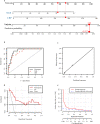Clinical features and death risk factors in COVID-19 patients with cancer: a retrospective study
- PMID: 34353293
- PMCID: PMC8340077
- DOI: 10.1186/s12879-021-06495-9
Clinical features and death risk factors in COVID-19 patients with cancer: a retrospective study
Abstract
Background: Coronavirus disease 2019 (COVID-19) has spread around the world. This retrospective study aims to analyze the clinical features of COVID-19 patients with cancer and identify death outcome related risk factors.
Methods: From February 10th to April 15th, 2020, 103 COVID-19 patients with cancer were enrolled. Difference analyses were performed between severe and non-severe patients. A propensity score matching (PSM) analysis was performed, including 103 COVID-19 patients with cancer and 206 matched non-cancer COVID-19 patients. Next, we identified death related risk factors and developed a nomogram for predicting the probability.
Results: In 103 COVID-19 patients with cancer, the main cancer categories were breast cancer, lung cancer and bladder cancer. Compared to non-severe patients, severe patients had a higher median age, and a higher proportion of smokers, diabetes, heart disease and dyspnea. In addition, most of the laboratory results between two groups were significantly different. PSM analysis found that the proportion of dyspnea was much higher in COVID-19 patients with cancer. The severity incidence in two groups were similar, while a much higher mortality was found in COVID-19 patients with cancer compared to that in COVID-19 patients without cancer (11.7% vs. 4.4%, P = 0.028). Furthermore, we found that neutrophil-to-lymphocyte ratio (NLR) and C-reactive protein (CRP) were related to death outcome. And a nomogram based on the factors was developed.
Conclusion: In COVID-19 patients with cancer, the clinical features and laboratory results between severe group and non-severe group were significantly different. NLR and CRP were the risk factors that could predict death outcome.
Keywords: C-reactive protein; COVID-19; Cancer; Neutrophil-to-lymphocyte ratio; Nomogram.
© 2021. The Author(s).
Conflict of interest statement
All the authors declared no potential conflicts of interest in this article.
Figures


Similar articles
-
Predictive Nomogram for Severe COVID-19 and Identification of Mortality-Related Immune Features.J Allergy Clin Immunol Pract. 2021 Jan;9(1):177-184.e3. doi: 10.1016/j.jaip.2020.10.043. Epub 2020 Nov 4. J Allergy Clin Immunol Pract. 2021. PMID: 33160092 Free PMC article.
-
[Predictive value of neutrophil/lymphocyte ratio on myocardial injury in severe COVID-19 patients].Zhonghua Xin Xue Guan Bing Za Zhi. 2020 Jul 24;48(7):572-579. doi: 10.3760/cma.j.cn112148-20200422-00336. Zhonghua Xin Xue Guan Bing Za Zhi. 2020. PMID: 32842269 Chinese.
-
Utility of the neutrophil-to-lymphocyte ratio and C-reactive protein level for coronavirus disease 2019 (COVID-19).Scand J Clin Lab Invest. 2020 Nov;80(7):536-540. doi: 10.1080/00365513.2020.1803587. Epub 2020 Aug 17. Scand J Clin Lab Invest. 2020. PMID: 32804580 Free PMC article.
-
A nomogram for predicting mortality in patients with COVID-19 and solid tumors: a multicenter retrospective cohort study.J Immunother Cancer. 2020 Sep;8(2):e001314. doi: 10.1136/jitc-2020-001314. J Immunother Cancer. 2020. PMID: 32895296 Free PMC article.
-
Clinical and laboratory characteristics of severe and non-severe patients with COVID-19: A retrospective cohort study in China.J Clin Lab Anal. 2021 Jan;35(1):e23692. doi: 10.1002/jcla.23692. Epub 2021 Jan 2. J Clin Lab Anal. 2021. PMID: 33389777 Free PMC article.
Cited by
-
Clinical characteristics and prognostic factors of COVID-19 infection among cancer patients during the December 2022 - February 2023 Omicron variant outbreak.Front Med (Lausanne). 2024 May 30;11:1401439. doi: 10.3389/fmed.2024.1401439. eCollection 2024. Front Med (Lausanne). 2024. PMID: 38873204 Free PMC article.
-
Effects of SARS-CoV-2 infections in patients with cancer on mortality, ICU admission and incidence: a systematic review with meta-analysis involving 709,908 participants and 31,732 cancer patients.J Cancer Res Clin Oncol. 2023 Jul;149(7):2915-2928. doi: 10.1007/s00432-022-04191-y. Epub 2022 Jul 13. J Cancer Res Clin Oncol. 2023. PMID: 35831763 Free PMC article.
-
Predictive value of systemic inflammatory index (SII) for the time to negative nucleic acid conversion in patients with mild COVID-19 by the omicron wave.Front Med (Lausanne). 2025 May 1;11:1474236. doi: 10.3389/fmed.2024.1474236. eCollection 2024. Front Med (Lausanne). 2025. PMID: 40376291 Free PMC article.
-
Using Telemedicine to Care for Patients with Breast Cancer: A Natural Quasi-Experimental Study.J Cancer Allied Spec. 2024 Aug 16;10(2):679. doi: 10.37029/jcas.v10i2.679. eCollection 2024. J Cancer Allied Spec. 2024. PMID: 39156945 Free PMC article.
References
MeSH terms
Substances
LinkOut - more resources
Full Text Sources
Medical
Research Materials
Miscellaneous

